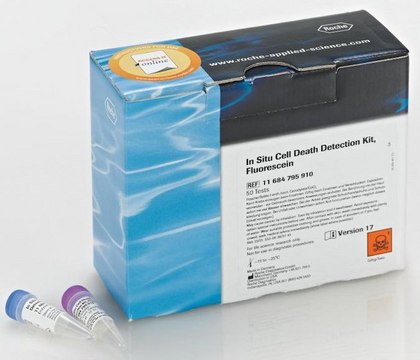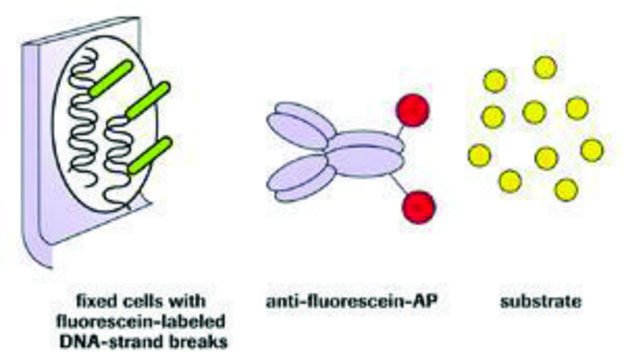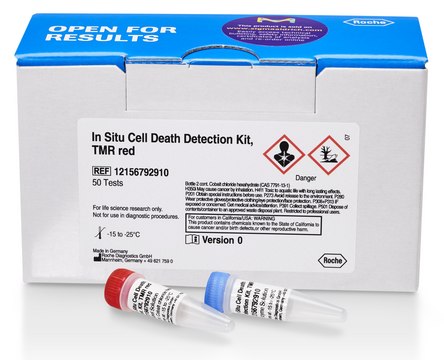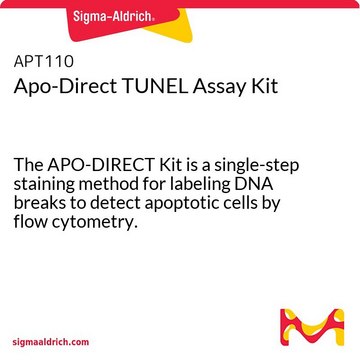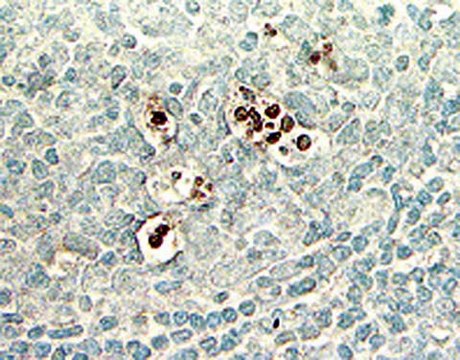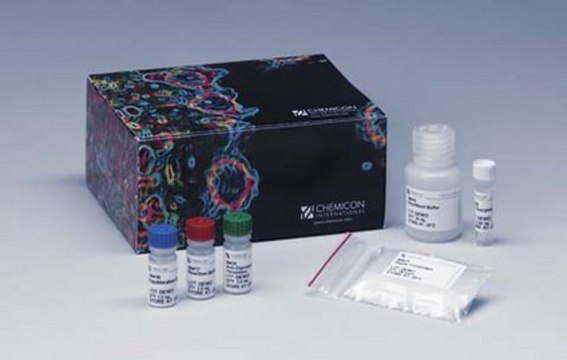M30-RO
Roche
M30 CytoDEATH
lyophilized (clear, colorless solution after reconstitution)
Synonym(s):
cytodeath, m30
Sign Into View Organizational & Contract Pricing
All Photos(1)
About This Item
UNSPSC Code:
12352200
Recommended Products
form
lyophilized (clear, colorless solution after reconstitution)
usage
sufficient for 250 tests (12140349001)
sufficient for 50 tests (12140322001)
manufacturer/tradename
Roche
shipped in
wet ice
storage temp.
2-8°C
General description
Mouse monoclonal antibody (Clone M30, mouse IgG2b) is used for the detection of apoptosis in epithelial cells (caspase cleavage product of cytokeratin 18). It is provided in lyophilized, stabilized, formalin grade form.
During apoptosis, vital intracellular proteins are cleaved. The proteases that mediate this process are called caspases (Cysteinyl-aspartic acid proteases). Caspases are expressed as zymogenes, which are activated by different apoptosis inducers. Once activated, a single caspase activates a cascade of caspases. Until recently, cytokeratins, in particular cytokeratin 18 (CK18), were not known to be affected by early events of apoptosis. Recently, it has been shown that the M30 antibody recognizes a specific caspase-cleavage site within cytokeratin 18, which is not detectable in native CK18 of normal cells. Consequently, the M30 CytoDEATH antibody is a unique tool for the easy and reliable determination of very early apoptotic events in single cells and tissue sections.
During apoptosis, vital intracellular proteins are cleaved. The proteases that mediate this process are called caspases (Cysteinyl-aspartic acid proteases). Caspases are expressed as zymogenes, which are activated by different apoptosis inducers. Once activated, a single caspase activates a cascade of caspases. Until recently, cytokeratins, in particular cytokeratin 18 (CK18), were not known to be affected by early events of apoptosis. Recently, it has been shown that the M30 antibody recognizes a specific caspase-cleavage site within cytokeratin 18, which is not detectable in native CK18 of normal cells. Consequently, the M30 CytoDEATH antibody is a unique tool for the easy and reliable determination of very early apoptotic events in single cells and tissue sections.
- Assay time: 2 hours for immunofluorescence on cells, 3.5 hours for staining of tissues (excluding dewaxing)
- Sample material: Adherent cells, tissue samples (routinely fixed and paraffin-embedded tissue sections, cryostat sections)
Specificity
The M30 CytoDEATH antibody binds to a caspase-cleaved, formalin-resistant epitope of the cytokeratin 18 (CK 18) cytoskeletal protein. The immunoreactivity of the antibody is confined to the cytoplasm of apoptotic cells.
Application
The M30 CytoDEATH antibody is used for the determination of early apoptotic events in cells and tissue sections by detection of a specific epitope of cytokeratin 18 that is presented after cleavage by caspases. Detect apoptosis by applying the M30 antibody to fixed samples, then using secondary detection systems suitable for immunohistochemistry, immunocytochemistry, and flow cytometry.
Features and Benefits
- Convenient: Easy-to-use standard protocol
- Clear results: Apoptotic cells are most easily distinguishable from normal cells
- Early detection of apoptosis: Detects caspase-cleaved Cytokeratin 18; caspase activity is one of the earliest apoptosis markers
- Useful for paraffin-embedded tissue: Useful for routinely fixed tissue samples; retrograde studies are possible
Physical form
White lyophilizate. The antibody has been lyophilized in the presence of proteinous stabilizers.
Preparation Note
Short protocol
For formalin-embedded tissue:
For immunofluorescence on cells:
For formalin-embedded tissue:
- Dewax formalin-fixed, paraffin-embedded tissue sections.
- Retrieve antigen by heating in citric-acid buffer.
- Add M30 antibody.
- Add Anti-mouse-biotin.
- Add Streptavidin-POD.
- Add substrate solution (DAB or AEC).
- Counterstain with Harris hematoxylin.
- Analyze under a light microscope.
For immunofluorescence on cells:
- Fix cells.
- Add M30 antibody.
- Add Anti-mouse-Ig-fluorescein.
- Analyze under a fluorescence microscope.
Working concentration: The concentration of the stock solution is 6,6 ng/ μl. For the QC-release test of this product, a function test using a cellular model (HeLa cells treated with TNF-α/Actinomycin D) is performed, as mentioned in the pack insert. The quantity of protein is only part of the QC-release test of the stock product that is why it is not included in the documentation.
Working solution: Procedure for Immunofluorescence in Cells and Flow Cytometry
When using other detection methods or sample material, conditions may vary and have to be adapted.
For application, dilute the antibody stock solution in Incubation buffer (M30 CytoDEATH).
Note: The antibody solutions should be free of precipitate. If necessary, centrifuge the solutions at high speed prior to use.
Additional working solutions required for the immunofluorescence and flow cytometry procedure:
Washing buffer: PBS containing 0.1% Tween 20
Incubation buffer: PBS containing BSA and 0.1% Tween 20
Procedure for Immunohistochemistry
When using other detection methods or sample material, the conditions may vary and have to be adapted.
Dilute the antibody stock solution in Incubation buffer.
Note: The antibody solutions should be free of precipitate. If necessary, centrifuge the solution at high speed prior to use.
Working solutions need to perform the immunohistochemistry staining procedure:
Washing buffer: PBS containing 0.1% Tween 20
Incubation buffer: PBS containing BSA and 0.1% Tween 20
Citric acid buffer: 2 g/l citric acid, pH 6 adjusted with 1 N NaOH
Storage conditions (working solution): The antibody stock solution is stable for 6 months at 2 to 8 °C. Alternatively, it can be stored in aliquots at -15 to -25 °C.
Note: Avoid repeated freezing and thawing.
Working solution: Procedure for Immunofluorescence in Cells and Flow Cytometry
When using other detection methods or sample material, conditions may vary and have to be adapted.
For application, dilute the antibody stock solution in Incubation buffer (M30 CytoDEATH).
Note: The antibody solutions should be free of precipitate. If necessary, centrifuge the solutions at high speed prior to use.
Additional working solutions required for the immunofluorescence and flow cytometry procedure:
Washing buffer: PBS containing 0.1% Tween 20
Incubation buffer: PBS containing BSA and 0.1% Tween 20
Procedure for Immunohistochemistry
When using other detection methods or sample material, the conditions may vary and have to be adapted.
Dilute the antibody stock solution in Incubation buffer.
Note: The antibody solutions should be free of precipitate. If necessary, centrifuge the solution at high speed prior to use.
Working solutions need to perform the immunohistochemistry staining procedure:
Washing buffer: PBS containing 0.1% Tween 20
Incubation buffer: PBS containing BSA and 0.1% Tween 20
Citric acid buffer: 2 g/l citric acid, pH 6 adjusted with 1 N NaOH
Storage conditions (working solution): The antibody stock solution is stable for 6 months at 2 to 8 °C. Alternatively, it can be stored in aliquots at -15 to -25 °C.
Note: Avoid repeated freezing and thawing.
Reconstitution
Reconstitute lyophilizate in 550 μl to obtain an antibody stock solution.
Other Notes
For life science research only. Not for use in diagnostic procedures.
Legal Information
The M30 antibody is made under a license agreement from Peviva AB, Sweden.
Regulatory Information
常规特殊物品
Choose from one of the most recent versions:
Already Own This Product?
Find documentation for the products that you have recently purchased in the Document Library.
Frédérique Souazé et al.
PloS one, 8(2), e55904-e55904 (2013-02-15)
Hath1, a bHLH transcription factor negatively regulated by the γ-secretase-dependent Notch pathway, is required for intestinal secretory cell differentiation. Our aim was fourfold: 1) determine whether Hath1 is able to alter the phenotype of colon cancer cells that are committed
Jo L McPartland et al.
International journal of experimental pathology, 86(1), 19-24 (2005-01-29)
Apoptosis is implicated as a major pathogenic mechanism in chronic hepatitis B and C. Previous studies of the relationship between apoptotic rates and histological necroinflammatory activity have produced conflicting results. Hepatocyte apoptosis was assessed in liver tissue from 32 cases
Grace C Roberts et al.
PloS one, 11(6), e0157004-e0157004 (2016-06-15)
3D cell cultures are emerging as more physiologically meaningful alternatives to monolayer cultures for many biological applications. They are attractive because they more closely mimic in vivo morphology, especially when co-cultured with stromal fibroblasts. We compared the efficacy of 3
R E Payne et al.
British journal of cancer, 106(11), 1790-1797 (2012-04-28)
Current approaches for detecting circulating tumour cells (CTCs) in blood are dependent on CTC enrichment and are based either on surface epithelial markers on CTCs or on cell size differences. The objectives of this study were to develop and characterise
Our team of scientists has experience in all areas of research including Life Science, Material Science, Chemical Synthesis, Chromatography, Analytical and many others.
Contact Technical Service